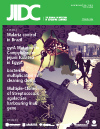Distribution of pathogenicity islands among Colombian isolates of Salmonella
DOI:
https://doi.org/10.3855/jidc.670Keywords:
Salmonella infections, Pathogenicity, Genomic islands, PCR, Virulence factors, SalmonellosisAbstract
Introduction: Salmonella pathogenicity islands (SPIs) are regions scattered along the bacterial chromosome, with an acknowledged pivotal role during gastrointestinal and systemic infection. The distribution of SPIs has been investigated in reference strains. However, there is a lack of studies on their presence and/or assortment within the genomes of Salmonella enterica (S. enterica) serovars that circulate in different geographical regions. Therefore, in this study, we aimed to determine the presence of genes of the pathogenicity islands 1 to 5 (SPI-1 to 5), in Salmonella clinical isolates from Colombian patients with systemic and enteric outcomes.
Methodology: A total of 125 strains of S. enterica belonging to different serovars were isolated from various clinical samples. Strains were identified and screened for the presence of various genes located in pathogenicity islands. The genes tested were selected according to the attributed pathogenic function and detected by PCR for the SPI-1 hilA and invA; for SPI-2 spiC and ttrC; for SPI-3 misL and mgtC; for SPI-4 orfL and SPI-4R; and for SPI-5 pipD and sopB.
Results: Salmonella pathogenicity islands 1 to 5 were detected in isolates from patients with systemic and gastrointestinal infection. All the systemic isolates possessed all the genes tested; in contrast, 16 isolates from stool samples lacked one or more sequences encoded by the SPI-3 and SPI-4 (p < 0.000001).
Conclusions: These results describe the heterogeneous distribution of SPIs-encoded sequences within the genomes of Colombian clinical isolates, and reveal important differences among systemic and stool sample isolates.
Downloads
Published
How to Cite
Issue
Section
License
Authors who publish with this journal agree to the following terms:
- Authors retain copyright and grant the journal right of first publication with the work simultaneously licensed under a Creative Commons Attribution License that allows others to share the work with an acknowledgement of the work's authorship and initial publication in this journal.
- Authors are able to enter into separate, additional contractual arrangements for the non-exclusive distribution of the journal's published version of the work (e.g., post it to an institutional repository or publish it in a book), with an acknowledgement of its initial publication in this journal.
- Authors are permitted and encouraged to post their work online (e.g., in institutional repositories or on their website) prior to and during the submission process, as it can lead to productive exchanges, as well as earlier and greater citation of published work (See The Effect of Open Access).








